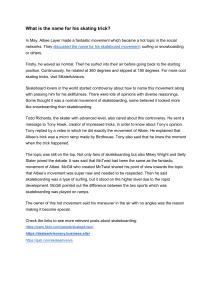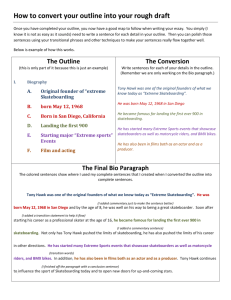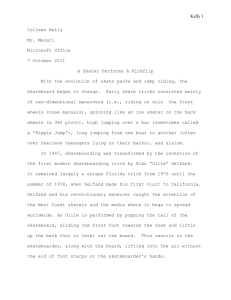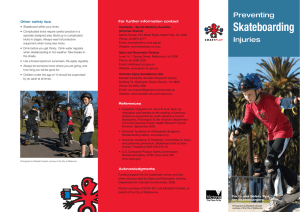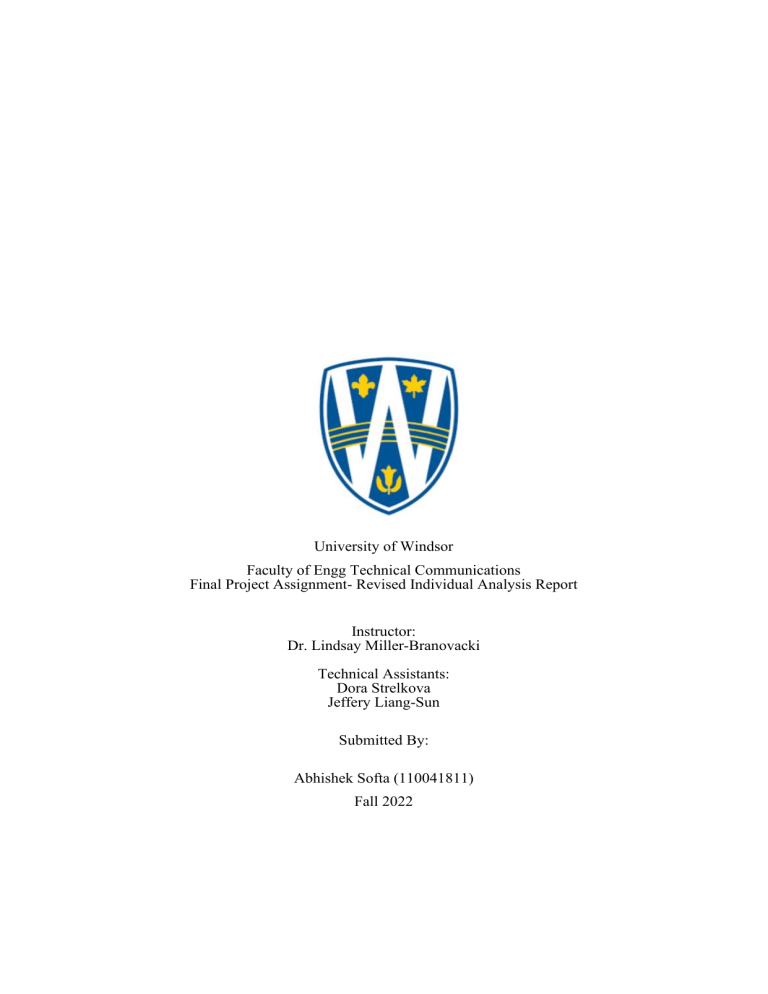
University of Windsor Faculty of Engg Technical Communications Final Project Assignment- Revised Individual Analysis Report Instructor: Dr. Lindsay Miller-Branovacki Technical Assistants: Dora Strelkova Jeffery Liang-Sun Submitted By: Abhishek Softa (110041811) Fall 2022 The Use of Bamboo as Alternate Base Material in Skateboards as Means of Reducing Maple Deforestation (Human Lens) Introduction The critical questions are other than just addressing the United Nations Sustainable Development Goals (SDGs). The challenge is first to make our solution (Skateboard) a desirable alternative mode of transport and successfully achieve the benefits of bamboo to people (farmers and consumers). Measure of Access Skateboards and other non-motorized devices are part of human-powered sustainable travel modes and a relatively famous form of mobility for more youthful people. [1]. Skateboarding is often associated with teenagers scrambling near the neighbourhood skatepark. Yet, a growing number of people use skateboards for a more practical intent called travel [2]. Transit riders in Los Angeles employ skateboards 30,000 times daily to fetch to and from bus stops and train stations [2]. A user can easily carry a skateboard onto a transit vehicle or car [2]. Social Perception & Barriers Many cynical stereotypes are associated with skateboarding, such as public and private property damage or skateboarding is done by an improper class of people [1,3]. “Skaters have a completely different culture from the norms of the world’s society. We dress differently, we have our own language, use our own slang, and live by our own rules. People feel threatened by foreign attitudes” [4]. Commuting is a common struggle for students on university campuses; only some people live on campus [5]. Skateboards are a cost-effective solution for commuting, but the problem with buying skateboards is that they are technically illegal on campus [5]. Effects on Community & Ecosystem A skateboard contains constituents with the major parts, including the deck, trucks, and wheels. Seven to nine sheets or veneers of maple wood are required to construct a single deck sourced from Canadian maple trees [8]. A farmer can get a bamboo harvest in one to three years with no additional planting, whereas a traditional maple wood takes at least 60 years to reach harvestable size [9]. Bamboo releases 30% more oxygen into the atmosphere and absorbs more carbon dioxide than other plants. Hence significantly decreasing the number of greenhouse gases in the atmosphere [10]. Positive Side The primary social connections that support health benefits from skateboarding are making new and reconnecting with old friends, bonding with skateboarding friendship groups, acquiring equal respect, and increasing opportunities to meet new people [6]. Regarding injuries, as shown in Figure1, skateboarding reaches the eighth place and emerges less threatening than most people think [7]. According to an assessment from a survey of skateboarders, skateboarding is very high in terms of fun and several measures of convenience Figure 2 [1]. Figure 1 Sports and recreational injuries [7] Figure 2 Skateboarders’ Survey [1] Conclusion • Skateboarding is infamous for wrong reasons and misconceptions. Still, social awareness and connecting with more classes of society can change this situation. • As a team, we need to endorse our project with the real benefits of a bamboo skateboard. References [1] K. Fang, S. Handy - " Skateboarding for transportation: exploring the factors behind an unconventional mode choice among university skateboard commuters”. Springer, p.2, 24 July. 2017, [Online]. Available, Doi: https://doi.org/10.1007/s11116-017-9796-9 [2] K. Fang - " Faster than walking, more flexible than biking: Skateboarding as a real mobility mode". Forbes.com, 2018, [Online]. Available,https://transfersmagazine.org/magazine-article/issue-1/faster-than-walking-moreflexible-than-biking-skateboarding-as-a-real-mobility-mode [3] Radikonyana, J.J. Prinsloo, T. Pelser, “The contribution of skateboarding to societal challenges”. African Journal of Hospitality, Tourism and Leisure, Aug. 2017, [Online]. Available,https://www.researchgate.net/publication/321920345_The_contribution_of_skatebo arding_to_societal_challenges [4] B. Beal, " Disqualifying the official: An exploration of social resistance through the subculture of skateboarding”. Sociology of Sport Journal, p.252-257,2003, [Online]. Available doi: https://doi.org/10.1123/ssj.12.3.252 [5] E. Alvarenga (2014) - " Let them skate". Published online at Surfertoday.com, 28 Oct. 2014, [Online]. Available http://thedailyaztec.com/58733/opinion/let-them-skate/ [6] A. Walker, et al., “Social benefits from skateboarding in skate-parks”. Researchgate, Jan. 2016, [Online]. Available,https://www.researchgate.net/publication/317760374_Rural_communitybased_maternal_and_newborn_interventions_on_prevention_of_neonatal_morality chapter 17, p.175 [7] “Skateboard Injury Statistics”, Jan. 2022, [Online]. Available https://skateboardsafety.org/injury-statistics [8] C. Puentes, “West coast to worldwide: The evolution of skateboarding”, Vol. 1, Issue 1, pp. 35-36, Dec. 2022. [Online]. Available https://scholarworks.calstate.edu/downloads/c821gq76c [9] D.O. Ekhuemelo, “Bamboo: A potential alternative to wood and wood products”. South Asian Journal of Biological Research, Vol. 1, Issue 1, pp. 1-11, Dec. 2022, [Online]. Available http://aiipub.com/journals/bamboo-a-potential-alternative-to-wood-and-woodproducts/ [10] R. Singh, “A Study on Employment and Skill Development through bamboo sector in Jharkhand”. (ARISCOM) Journal of Management, (Print) Vol.1, Issue 2, p. 50, Dec. 2022.

